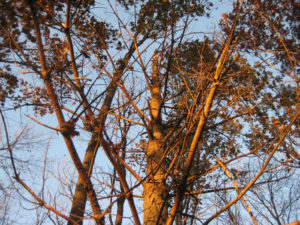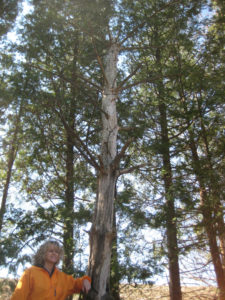Sacrificial Conifers

If you are thinking about planting a native woodland of oaks, hickories, black walnut, and their associates, consider including some non-native conifers in the mix. It doesn’t really matter which conifer species you choose, because with the exception of red cedar, they are all aliens to southeast Iowa and their fates will all be the same, which is that over a period of 20 to 25 years the nearby hardwoods will gradually outcompete and kill them.

This white pine lived for about 20 years and has been dead for about 4 years. It’s just starting to disintegrate at the top.
So why bother planting them?
When your conifers and their future hardwood competitors are young, the hardwoods offer little cover or shelter from the winter wind for wildlife, but the conifers will. By the time the conifers are 5 or 6 feet tall, robins and mourning doves will be nesting in them, and rabbits will nest on the ground below their thicket of lower branches. If you plant them in groups of a half dozen or more, they will become a winter shelter for owls, other birds, deer, and smaller mammals.
Single young conifers surrounded by young hardwoods can start showing stress by age 15 and are commonly dead by age 20 or 25. Small groups with no hardwoods amongst them can buy themselves another 5 or 10 years.
Once dead, these conifers continue to play a useful role, including invasion by insects, which woodpeckers and flickers pursue by drilling holes – which then become homes for cavity nesters.

This white pine lived for perhaps 20 years, and has been dead for about 10 more. Note the trunk has shed most branches and the woodpeckers are chipping it away from the top down.
When hardwoods die, they commonly rot off just below the soil surface and then topple over as a unit, often damaging other young trees. But conifers are loaded with resin, especially the older wood, which resists decay. So they usually disintegrate slowly, in small pieces, from the top down. A pine or spruce that lived for 20 to 25 years may linger on for another quarter century as a dead snag, supplying insect habitat and homes for birds and mammals, while building up the forest floor soil, supporting woodland wildflowers.
The message here, also, is that if you are planning a conifer windbreak for your house and yard for protection from the winter wind – and expect it to function well for 50 or 100 years – do not plant or allow hardwoods to grow amongst or beside them, because the same competitive process will get underway.
So, in conclusion, mixing sacrificial conifers into your native hardwood planting can jump start this planting’s habitat value by perhaps 40 to 50 years. By then your hardwoods will have gotten deeper into their own life cycles, including damage like heart rot, storm breakage, lightning strikes, termites, disease, drought, fire, etc., and they will continue to provide habitat value where the now-vanished conifers left off. And your planting will be well on its way to becoming old growth of just natives.


